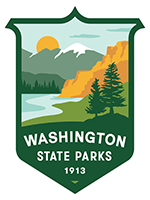Search results
1015 results found
OLYMPIA — Washington State Parks will perform its annual mooring buoy maintenance at marine state parks in Puget Sound and the San Juan Islands in June.
This ongoing maintenance creates safe conditions for boaters who tie up to buoys at marine state parks and recreate or sleep in their vessels.
The following parks will have limited mooring buoy availability during the following timeframes:
The Washington State Parks and Recreation Commission (Parks) invites the public to participate in conversations about a potential expansion of Riverside State Park.
Flaming Geyser State Park straddles the Green River at the lower end of the Green River Gorge, a unique place where sandstone bedrock, covered by glacial deposits in most of the Puget Sound lowlands, is revealed by the downcutting of the river through the formation. Seams of coal interwoven with the sandstone fueled a mining industry in the local area. On October 4, 1911, coal miner Eugene Lawson drilled a test bore in today’s park area, attempting to locate a coal seam. At 390 feet deep, he found a seam 6.5 feet thick.
Lyons Ferry State Park occupies a place at the drowned confluence of the Palouse and Snake Rivers, where people have crossed over the rivers for millennia.
Ice Age Floods Carve a Canyon
The walls of the Snake and Palouse River Canyons, and the cliffs which soar over the park are made of basalt lava flows that erupted from vents in southeast Washington. The forces of plate tectonics continue to shape this landscape, wrenching and stressing the vast layered basalt flows that make up Washington’s Columbia Plateau, weakening the rock along subtle fractures.
The Washington State Parks and Recreation Commission is developing a long-range plan for its property located on Miller Peninsula. This 2,800-acre undeveloped park is located in the north Olympic Peninsula, just east of Sequim and north of Highway 101 in Clallam County. The property includes a trail system for hikers, mountain bikers, and equestrians through a beautiful second-growth forest.
OLYMPIA – Aug. 31, 2022 – Washington State Parks will close the lower parking lot and all restroom facilities at Tolmie State Park near Lacey on Tuesday, Sept. 6 to complete a fish passage project.
The upper lot at Tolmie will remain open, with space for 30 cars, and portable toilets will be available during construction. The work is set to start in September and wrap up in February of 2023. Visitors will be able to reach the beach on a steep trail from the upper parking lot.
Blind Island Marine State Park is a favorite campsite for kayakers located in the heart of the San Juan Archipelago a short distance offshore from Shaw Island.
A Rocky Island
The San Juan Islands are distinct from most of Puget Sound in that they feature shorelines with exposures of hard bedrock, rather than the bluffs of clay, sand and gravel left by Ice Age glaciers that are predominant on most of Washington’s Salish Sea, the state’s inland saltwater passages.
Posey Island Marine State Park is a small island featuring a popular campsite for kayakers that is easily accessible from the northwestern part of San Juan Island.
A Rocky Island
The San Juan Islands are distinct from most of Puget Sound in that they feature shorelines with exposures of hard bedrock, rather than the bluffs of clay, sand and gravel left by Ice Age glaciers that are predominant on most of Washington’s Salish Sea, the state’s inland saltwater passages.
Turn Island Marine State Park preserves an entire island that lies just offshore from a point on the eastern side of San Juan Island.
A Rocky Island
The San Juan Islands are distinct from most of Puget Sound in that they feature shorelines with exposures of hard bedrock, rather than the bluffs of clay, sand and gravel left by Ice Age glaciers that are predominant on most of Washington’s Salish Sea, the state’s inland saltwater passages.
Saint Edward State Park hugs the shore of Lake Washington, the second largest natural lake in Washington, surpassed in area only by Lake Chelan. Tongues of the great Pleistocene glaciers that excavated the passageways of Puget Sound also dug the nearly 20 mile long basin of Lake Washington. For thousands of years, the lake received fresh water from the Sammamish River at its north end and drained through the Black River into Puget Sound at its south end.
OLYMPIA — Nisqually State Park will temporarily close beginning Jan. 27 for phased maintenance and construction work as park development continues. The park is expected to reopen to visitors in the fall.
Lime Kiln Point State Park provides an opportunity for park visitors to view orca whales from shore in an area with connections to the cultural stories of the picturesque San Juan Islands.
Suspect Terranes
The bedrock landscape of the San Juan Islands is made of assemblages of rocks called terranes that have been thrust over one another like a stack of cards by tectonic forces.
